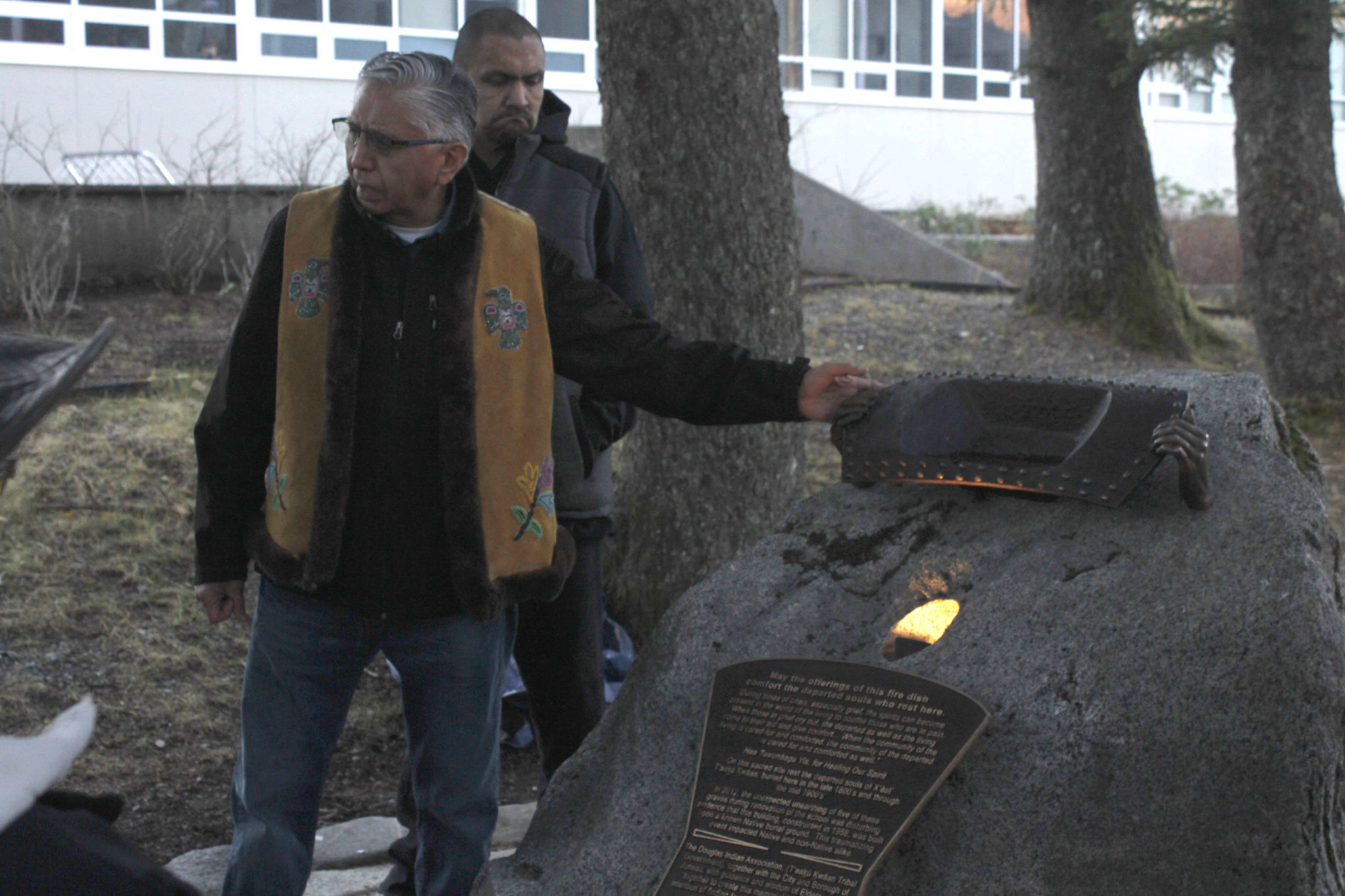Clarence Laiti stood in the cafeteria of Sayéik Gastineau Community School — which was built on a Tlingit burial ground — and reflected on times he’s visited the graves of departed relatives in cemeteries.
“You always end up talking to them,” Laiti said. “At least I do.”
On Friday afternoon, the ongoing conversation between the dead and the living was on full display at the school.
Laiti, the president of the Douglas Indian Association (DIA), and fellow DIA members unveiled a memorial in a grove of trees in front of the elementary school to honor the people who are or were buried in the burial ground. The memorial, called Sayéik Sacred Site Memorial, is the latest in a series of additions at the school to pay tribute to the atrocities that have happened at the site over the years.
In 1956, the city paved over a Tlingit burial ground to build a highway and the school. In 1962, the city of Douglas burned down the Douglas Indian Village to make way for Douglas harbor.
When the school was being renovated in 2012, contractors inadvertently unearthed five graves. Since then, the City and Borough of Juneau has worked with the DIA to acknowledge the past and to try to heal the deep wounds that were caused by previous events.
In the past two years, a Raven totem pole was raised in front of the school and the Tlingit name for the area, Sayéik, was added to the school’s name.
The Sayéik Sacred Site Memorial, which was designed by Tlingit/Unangax multi-disciplinary artist Nicholas Galanin, includes a few main aspects. The focus of it is a ceremonial bronze fire dish, which is symbolic for the Tlingit practice of placing food into a fire to feed and comfort the spirits of the departed.
Just below the fire dish is a light, representing an eternal flame. Below that is a bronze plaque in the shape of a Tináa that explains the significance of the site and memorial. The memorial is built on a granite boulder. There’s a stone path leading from the memorial to the school’s entrance.
In front of the entrance is a large semi-circle of bronze that carries words from the late Tlingit elder Elizabeth Nyman: “You are truly precious, [you and] all the Children of the Yanyèidi, [and those whose names come] from the Taku River. Therefore I want you to see your background, your history, what happened in the past. As long as [I live] — I will not live forever, but those of you who come after will read it. If only you were taken by boat along the Taku River you could write down the whole story in a book.”
Galanin’s work has gained attention from people around the country, and he’s been heavily involved in the healing process on Douglas Island. He was the lead carver on a Wolf totem pole that went up at Savikko Park earlier this year.
Galanin wasn’t able to attend Friday’s unveiling ceremony, but many people made sure to praise his work on the memorial. University of Alaska Southeast Assistant Dean Ronalda Cadiente-Brown said it was clear from early on that Galanin was the correct choice for the project.
“He delivered in a variety of ways,” Cadiente-Brown said. “I had such a sense that the work was in the right hands and appreciated that he is now tied to this community both with the poles he was involved with and with this piece.”
The memorial was a collaborative effort between the DIA, CBJ, Juneau School District and North Wind Architects. Representatives from all of those organizations were present Friday, but it was a fairly small ceremony with about 40 people in attendance.
DIA Tribal Administrator Andrea Cadiente-Laiti did much of the moderating during the ceremony, but DIA Secretary Barbara Cadiente-Nelson and Tlingit elders David Katzeek and Paul Marks also spoke at length. Katzeek and Marks, who often team up to speak at important Tlingit events and ceremonies, spoke just before the memorial was unveiled.
They talked about their personal experiences with the school and the area and about how important it is for the children attending the school to understand the significance of the land they’re on. Katzeek spoke at length about the example that the totem pole and memorial are setting, but more importantly he spoke about the example that the people working together to put them up are setting.
“We’re holding each other up, encouraging each other,” Katzeek said. “Our children need to see that. This nation needs to see.”
• Contact reporter Alex McCarthy at 523-2271 or amccarthy@juneauempire.com. Follow him on Twitter at @akmccarthy.

